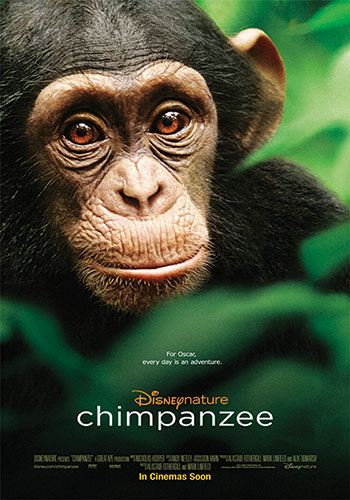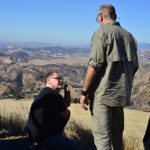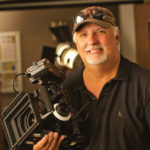
Disney’s Chimpanzee
Posted on Nov 22, 2012 by Alex Fice
Oscar and Freddy bond in the Tai Forest National Park, Ivory Coast.
Massively experience wild life producers Mark Linfield and Alastair Fothergill joined wild life cameraman Martyn Colbeck in shooting Disney’s Chimpanzee in the harsh conditions of Ivory Coast’s Tai Forest National Park.
Disneynature’s Chimpanzee tells the story of Oscar, an orphan chimpanzee, adopted and raised by elder male Freddy – an unusual relationship never caught on film before. But this remarkable story set in the dense rainforest of the Tai Forest National Park in Ivory Coast very nearly didn’t make it to the big screen. “I’d filmed monkeys in that forest before and it was incredibly challenging,” explains Director/Producer Mark Linfield. “In fact when (cameraman) Martyn (Colbeck) and I left that shoot we pretty much whooped for joy. We both looked at each other and said thank God we never have to come back here.” Less than 10 years later Mark found himself back in the same forest recce’ing for Chimpanzee.
“I’d been there for almost a week with fellow director Alastair Fothergill and had seen nothing that reassured me making a full length feature was a good idea,” says Mark. “For the first few days it was every bit as difficult as I remember, but then on the last day we had an amazing scene sitting in a clearing with the young chimpanzees playing, the teenagers larking around as they do and the adults grooming each other. You could see the film unfolding in front of your eyes and I thought my God, this could be possible, if we could have a few scenes like this we could really make a movie. It’s safe to say we never saw a scene like that again!”
Despite this, the team still managed to make a beautiful film which highlights just how similar chimpanzees are to us, not just in the dry sense of being genetically close, but in the way they have distinct characteristics and personalities. What’s more, they managed to do this in the harshest of filming conditions. Central to their achievement was the Panasonic AJ-HPX3700 P2 HD VariCam, which offered the crucial balance of robustness and portability, as well as a raft of other key features, which made it appropriate for the job in hand.
Testing Conditions
The physical demands of filming in the Tai Forest National Park – very hot temperatures, humidity between 85-100% and seasonal torrential rain showers – are wearing, not just on the crew but also on the kit, so it needs to be robust. The remoteness of the location also called for it to be as light and portable as possible. Generally speaking, the more robust the camera, the heavier it is. Martyn was looking for something extremely special from the AJ-HPX3700 if it was to meet all his requirements. “Walking 15km a day through hot, humid rainforest with a camera bouncing around on your back is tough,” recalls Martyn. “The Panasonic camera was substantially lighter than the next camera we would have considered. What’s more, it never failed once in 350 shooting days.”
Harsh environmental conditions also meant that Martyn needed to shoot on a tapeless format – tape performs notoriously badly in high humidity. However, a lot of tapeless cameras are very power hungry, requiring either enormous batteries or numerous spares, which again reduces portability. The AJ-HPX3700 runs on relatively small lithium-ion batteries, which lasted a surprisingly long time. This meant that Martyn was easily able to take six batteries with him every day, but the energy use was so good he never once needed to use them all.
Another key factor in portability is the weight of the lens, especially when shooting primarily on telephoto lenses as Martyn was. The Panasonic camera has a 2/3in image sensor, which means the full package is much lighter. Mark explains: “The big dividing line at the moment is between cameras that have large 35mm sensors and those that have smaller 2/3in sensors. If you look at the lens that could achieve the same results as our standard zoom for a 35mm camera like the ALEXA it would be enormous and prohibitively heavy. Cameras with 2/3in sensors are often better for wildlife subjects because the lenses are much lighter, with a greater zoom range and better ‘reach’ for distant subjects. It is possible to put a 2/3in lens on a 35mm sensor camera but you simply lose too much light to the adaptor for many uses.”
High Contrast Situations
Mark and Martyn knew chimpanzees had the potential to deliver a dramatic storyline, but they had huge doubts over whether they could actually film it. “One of the fundamental difficulties with chimpanzees is that they are black animals living in dark shadows, which basically means that your light meter reading is hovering somewhere around zero a lot of the time,” explains Martyn. “And then to make matters worse, you have a broken canopy overhead so you get bolts of incredibly bright sunlight coming through.”
Age-old tricks to avoid the worst of the contrast, like reframing, were not always possible, especially in dense vegetation, so a camera with great contrast handling was crucial. The AJ-HPX3700 was able to offer this. The Y-Get spot meter, a feature unique to the Panasonic VariCam, enabled Martyn to read the specific exposure on very isolated bits of the frame, which was invaluable. If the shot is slightly underexposed then the shadow, in Martyn’s case the chimpanzee, would appear completely black. The Y-Get enabled him to avoid this situation in a vast majority of cases. “When you’re filming you’re not just thinking about the animal, what its doing and where its going next, you’re also constantly aware of the light, shadows and highlights. Just to be able to check exposure very quickly and accurately with the Y-Get was really useful,” explains Martyn.
However, in some cases, the light conditions were so difficult it wasn’t always easy for Martyn to correct overexposure using the camera’s features alone. As Mark explains, the camera’s built-in Neutral Density Filter offered a neat way to resolve this particular challenge in post-production. “If there was a very bright area in the frame that was burning out and Martyn couldn’t give the picture less exposure because the chimpanzees were going black, he would keep the correct exposure on the chimpanzee then when it had left the frame he’d keep shooting for a bit longer, turning down the exposure with the Neutral Density Filter, allowing him to record the detail in the previously burnt out section. We’d then use that section to replace the burnt out piece in post-production. We used this technique to repair burnt highlights in quite a few shots.”
Clear Picture on Focus
Since chimpanzees are so susceptible to human diseases Martyn and his assistant Ed Anderson had to keep a distance of at least seven metres throughout the shoot, which presented a challenge when filming through incredibly dense rainforest. Shooting primarily on telephoto lenses in low light conditions meant they were working with maximum aperture, which translated into a very limited depth of field. This meant focus became crucial.
Martyn explains; “Since we were shooting for the big screen, it was critical that the chimpanzees’ eyes or at least the eye nearest to camera was always in focus. The black and white CRT viewfinder on the AJ-HPX3700 was incredibly crisp and made this task much easier. It really was a crucial feature.”
Martyn’s love for the Panasonic black and white CRT viewfinder may come as a surprise to many camera operators who prefer to use colour LCD panels. “There’s a lot of debate among cameramen about whether to use a colour LCD or a black and white CRT viewfinder,” says Mark. “They both have advantages but there’s an assumption that colour is better. However, LCD panels tend to smear with movement, which makes focus really tricky when either the camera of subject is moving. Black and white CRTs don’t do that, making it much easier to judge focus. Judging exposure can also be easier with a black and white image. The Panasonic viewfinder was particularly good for this purpose.”
In Praise of P2
The Panasonic P2 workflow offered many benefits both on location and in post-production. Importantly, the cameras are extremely quiet and non-intrusive and the start up time very fast. “With two P2 cards it takes only 10 seconds from switching on the camera to being ready to shoot,” says Martyn. “When we got to a suitable position in which to film my assistant would set up the tripod. I’d put down my backpack, open it, switch on the camera, and by the time I had it on the tripod it was ready to go.”
Being tape-free was also a huge advantage. The AJ-HPX3700 takes five 64GB P2 cards. “You have around a gigabit a minute, meaning almost six hours of recording time, not that I could get six hours a day,” jokes Martyn. “They slot into the side of the camera and you can film all day without having to change anything. You don’t need to worry about changing tapes or getting to the end, it just happens automatically.”
The solid-state system, coupled with a small monitor on the side of the camera, enabled Mark and Martyn to access images immediately, meaning unwanted footage could be deleted at the touch of button before being digitised. “You can access each individual file you’ve shot and check it. For example, if it’s over-cranked you can see. Being able to check shots like this was just so useful,” says Martyn. Previously, with tape-based formats, Martyn would not have been able to check whether he’d chosen the right frame rate until he was back at the studio in Bristol, thousands of miles away from location.
Mark adds: “Unlike tape, the rushes are file-based and already ‘digitised’ so you can instantly work on them, deleting duff clips on the computer so you’re saving on the amount of material you download. You save a fortune on tape, as well as the cost of shipping it half way across the world. It also has benefits when it comes to cloning rushes – about which our insurance company is justifiably militant.”
The P2 system enabled Martyn to make two byte-for-byte copies of the footage every evening when he was back at camp, which was much better than any system he’d used before. There was no worry about building up reams of tape, nor of the footage getting damaged through sunlight, humidity or even x-ray machines at the airport.
One final key benefit of the P2 workflow was the ability to edit the original master footage ‘natively’ in Final Cut Pro. Mark explains; “The original P2 files that were in the camera were those we actually used in the edit. We didn’t have to make editing copies because the codec was quite a nice weight and worked in Final Cut Pro. That meant two very significant things. First, you could actually see your final image quality in the offline edit so there was no guesswork over image quality which can be the case when you edit using lower quality ‘proxies’ – and having final image quality in the offline environment does influence your editorial decisions. Second, you save time and money because there is no need to make proxies and there is no need to conform. You cut your actual material and when you’ve finished it, that’s it.”
 Disneynature’s Chimpanzee was a movie release in 2012.
Disneynature’s Chimpanzee was a movie release in 2012.
Boosting Morale
The ability to review footage each evening was instrumental in keeping up morale during long and gruelling shooting schedules – up to 13 weeks at a time, with one day off in every four. “It’s not just the physical demands which were extreme but the intense claustrophobia you experience in the dense vegetation of the rainforest. You spend weeks where you can’t really see more than a few metres in front of you,” recalls Martyn.
“Anywhere else it would have made sense to leave the forest and go to the local town for a bit, see the horizon and reset. But we couldn’t do that because the chimpanzees are very susceptible to human diseases. If you ever leave the forest you have to go into an eight-day quarantine. Once you’re in, you’re in. And that’s why keeping up morale is so important,” adds Mark.
Cinematic Quality
Finally, the Panasonic VariCam is well-known throughout the industry as a video camera that captures images with an appealing warm, film-like tone and texture. It was this cinematic image quality that particularly appealed to Mark. “Instead of a video look the Panasonic camera offers a more film-like quality, which most people find much more pleasing on the eye. Panasonic has long been a pioneer in this sort of look and is very good at it. As well as this, we also needed our camera to shoot Full HD. 720 does not really have the resolution that you need for the big screen especially on big wide angle scenes where it can look a bit ‘soggy’. Its fine for HDTV and a lot of people would struggle to tell the difference here but for the big screen it’s got to be 1080 at least. This was a critical feature of the AJ-HPX3700.”
Choosing the best camera to shoot a feature is dependent on many factors – light levels, weather conditions, remoteness and accessibility of the location, nature of the subject, and suitability of workflow, not to mention budget constraints. For the Chimpanzee team the Panasonic AJ-HPX3700 was the hands-down obvious choice for the job. Director/ Producer Alastair Fothergill concludes: “In all my career as a wildlife filmmaker I cannot remember a more demanding challenge than making a movie for cinema on chimpanzees. So many factors are against you. But we were very lucky in our choice of camera.”














